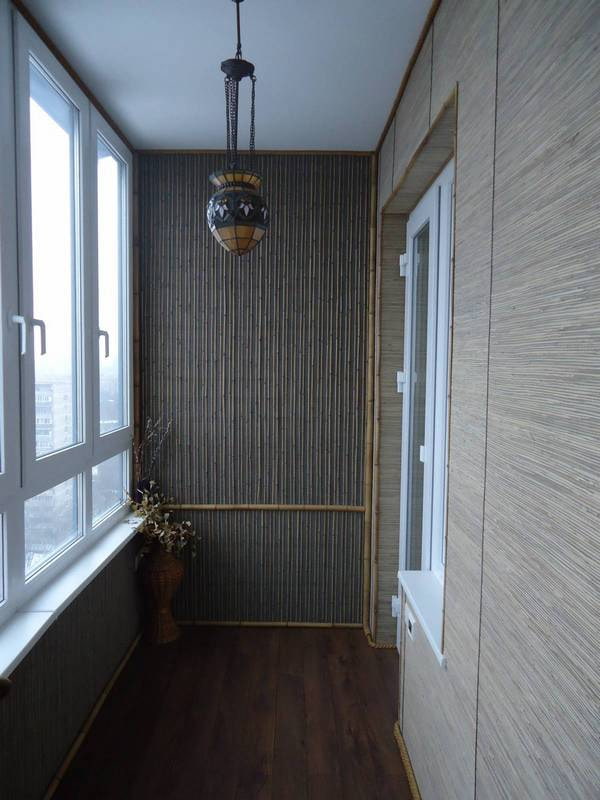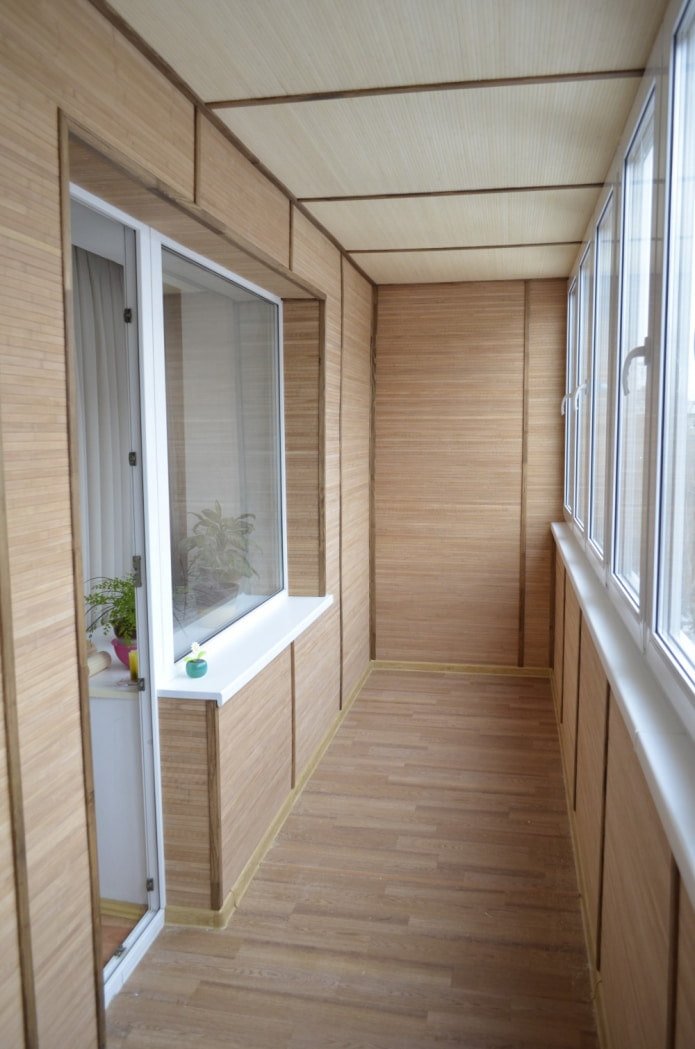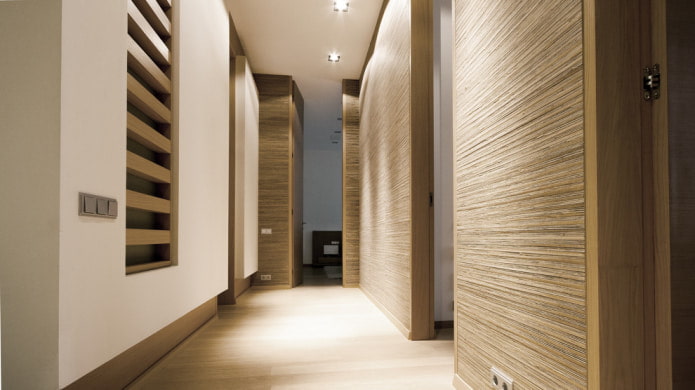What is bamboo wallpaper?
Bamboo wallpaper is an environmentally friendly and completely natural finishing material that is made from different parts of the bamboo trunk. The material “breathes”, is “not afraid” of contact with water and is easy to care for. Considering the environmental friendliness of bamboo wallpaper, they do not cause allergic reactions and are completely safe for children.
Production technology
The canvases are made from unpainted bamboo stem, which after processing is attached to a fabric base. Different parts of the stem are used to obtain different visual effects. They are pre-split and processed, after which they are “sat” on a gauze base.
Characteristics
Wallpaper can have different parameters, for general convenience, rolls are produced with certain sizes.
Types
From the outer part of the trunk
Wallpaper is made from the upper (outer) layer of the bamboo stem. The texture and patterns of the trunk are clearly visible on the canvas, the joints and structure are visible. There are several types by surface color: yellow, green, chocolate, tortoiseshell and pistachio.


The photo shows a city apartment in a marine style. The design is refreshed by turquoise furniture and decor items.
From the inner part of the trunk
The canvas is obtained by processing the inner parts of the stem. The planks are carefully processed and polished to obtain a perfectly smooth surface. After processing, the slats are fixed on a gauze base.
The wallpaper from the inner part is also divided into types by color: light, dark, wenge. The light surface is natural, unpainted bamboo. To obtain a dark canvas, bamboo is tinted by heating it to 60 degrees. To obtain a wenge tone, bamboo stems are painted. In addition, the surface can be varnished.

Combinations of bamboo and reed
The design can combine canvases from different materials. The plants are visually similar, but have different characteristics. Reed wallpaper is resistant to light, but more vulnerable to moisture. Bamboo and reed can be in the form of different canvases or combined in one, alternating slats.

Pros and cons
Any finishing material has advantages and disadvantages. Taking into account the nuances and features of bamboo wallpaper, you can create not only a beautiful, but also a practical design.
Photos in the interior of rooms
In the interior of the hallway
The most practical finishing material for the corridor and hallway. Considering the possible frequent contact with clothing and footwear, bamboo wallpaper will be a good solution.

They are easy to keep clean, just wipe the dirty area with a slightly damp cloth. Bamboo goes well with plain surfaces, plaster and wallpaper with a plant pattern.

In the kitchen
In the kitchen, bamboo wallpaper is suitable for finishing both the dining area and the work area.

The photo shows a spacious kitchen-dining room. The finishing is made of natural materials: bamboo wallpaper, stone, wood.
For finishing the kitchen apron area, it is worth considering the presence of protective glass. It is necessary to protect the surface from contamination, as well as for safety purposes.

On the balcony or loggia
A good way to beautifully decorate a balcony or loggia. By adding some decorative elements to the finishing, you can get an interesting and warm interior.

The photo shows a balcony with an unusual finishing method. The installation of bamboo wallpaper is done according to the mosaic principle, contrasting white moldings emphasize the non-standard arrangement of the canvases.
In addition, bamboo wallpaper will become an additional soundproofing layer and, unlike ordinary paper wallpaper, it will not fade or peel off at high temperatures.


In the bedroom
Bamboo canvases will give the bedroom the coziness and warmth of a tropical house. They can be combined with a single-color wall decoration, in which case the design will be calmer, or completely decorate the room with them.

The photo shows a bedroom in a marine style. Colors and multiple details support the theme of the room.

Partial decoration, for example, the wall above the headboard or the doorway, will be an interesting interior solution.

In the children’s room
The children’s room will become much more interesting if it is decorated thematically, for example, in a marine, tropical or Asian style. Cute details will complete the look of the room.

In addition to the aesthetic side, bamboo wallpaper is completely safe for children.

The photo shows a children’s room in Japanese style. The room’s decoration and filling are made of natural materials.
In the hall
Using bamboo decoration in different color variations, you can get a completely different look for the living room.

Painted in light colors, the canvases will decorate classic, modern and marine designs. Dark wall decoration is more suitable for a modern trend, and also looks good in contrast with a light tone.

In the bathroom and toilet
Bamboo decoration can also be used in the toilet, the material interacts well with humidity and does not deform over time.

However, for places where contact with with direct water, it is still worth choosing tiles.


Color range
Ivory color
Neutral, the lightest shade of bamboo canvas. The color will decorate both a delicate classic interior and a stylish modern design. It goes well with finishing of other materials and colors.

The photo shows a stylish living room in a modern style. The accent wall is finished with bamboo wallpaper and decorated with a built-in bio-fireplace.
Tortoiseshell
The color is called tortoiseshell, since the surface of the canvas has brown spots similar to tortoiseshell. The background can be milky, brown or green. Wallpaper of this color is best combined with other, more subdued, single-color coverings, otherwise the interior may turn out gaudy.

Wenge
The combination of a beautiful dark color and an interesting texture will make the interior stylish, but not pretentious. Wenge harmonizes well with light tones, such as white or beige, and also looks good as the main color for well-lit rooms.

Green
Green bamboo is similar in color to olive. The shade is calm, not bright, looks good in a room with windows facing south. A good option for finishing a children’s room, kitchen or living room, the color is calming and has a beneficial effect on human psychology.

Brown
A warm shade can have different tones from light to dark. Suitable for interior design in a modern, Asian and ethnic style.

The photo shows a dining room in eco-style. The finishing and furniture are made mainly from natural materials.
What can it be combined with?
With cork flooring
Natural materials harmonize with each other with their warm color, in addition, both coverings are environmentally friendly and do not cause allergic reactions.


With other types of wallpaper
The interior can be made brighter or, on the contrary, more delicate with a combination of other wallpapers. Different types of coverings allow you to choose the best option that will match a given room. For example, paper wallpaper is suitable for a bedroom or a nursery, non-woven wallpaper for a living room, and vinyl wallpaper for a kitchen.


With wooden panels
Natural eco-friendly coverings will support the overall theme of the room’s interior.

With plaster
Plastered walls will make the room design “calmer”. Bamboo panels will stand out against the plaster. A great combination for highlighting an accent wall or other areas.


With stone or brick
Brick and stone, in addition to the aesthetic side, also perform a protective function, protecting corners from scuffs and dirt.

Presentation in various styles
Japanese style
Bamboo trees are inextricably associated with Japan or China. The Japanese style is laconic and not pretentious. The details are minimalist and not bulky. Bamboo wallpaper can frame all the walls or highlight certain areas of the room. The design will be complemented by decorative pillows with thematic drawings, a group of small paintings and other decorative items. Bamboo finishing goes well with themed photo wallpapers.


Eco-style
Eco-style is distinguished by the maximum filling of the interior with natural materials, from the finishing to furniture and decor. Bamboo wallpapers fully correspond to the features of the style and successfully emphasize it. Eco-style creates a calming and cozy atmosphere that allows you to abstract from the daily city routine.


The photo shows a compact kitchen, completely finished with bamboo wallpaper. The eco-theme in the interior is supported by curtains, vases and a rack made of natural bamboo.
Ethnic style
Ethnic motifs in the interior of the house have a special mystery and charm. Ethnic design is suitable for decorating a bedroom or living room. Any shade of bamboo will look harmonious in combination with ethnic furniture, for example, with African motifs, unusual decor and subdued lighting.


Finishing non-standard surfaces
Ceiling
Finishing the ceiling with bamboo wallpaper will create the atmosphere of a tropical house. High ceilings can be complemented with wooden beams or a ceiling fan. If the room does not have high ceilings and has standard dimensions, but bamboo flooring can be combined with a stretch or suspended ceiling of a light shade.


Arch
The arch can be decorated in different variations, for example, finishing the end part of the arch, creating an arch from wallpaper or completely finishing the wall, including the arched opening. Any option will make the interior more interesting and will not overload it.

Doors
Bamboo wallpaper on doors can echo other decoration fragments or furniture items. In addition, this method can be used to “refresh” an old door, correcting the signs of time.

How to glue?
What to glue with?
There are several types of glue that are suitable for bamboo wallpaper. Among them, there is no glue for ordinary wallpaper, it is too weak for this material.
- The first option is liquid nails, a reliable method, but has disadvantages in the form of an unpleasant odor and substances harmful to humans.
- PVA glue can hold the wallpaper, but this will require a lot of effort, since it takes a long time to set. In addition, for reliability, it is worth using screws or nails.
- Acrylic glue, otherwise called “crazy Velcro”, is not directly intended for bamboo wallpaper, but it copes with them perfectly, is safe and easy to work with.
- There is also a special glue that is designed for bamboo canvas and cork.
What to cut with?
Simply cut the material across the canvas, a wallpaper or stationery knife will be enough. To divide the roll lengthwise, you will need a tool, this can be an electric jigsaw with a metal saw or a hacksaw for metal.
Step-by-step instructions for gluing
The process of gluing bamboo wallpaper can be divided into several stages.
- Preparing the material. First, you need to prepare and cut the canvas into fragments of the desired size. To do this, you will need a wallpaper knife or a jigsaw, depending on the place of the cut.

- Preparing the walls. The surfaces do not require careful preparation, since the bamboo cloth masks small irregularities well. However, it is necessary to remove old wallpaper and plaster.
- Apply the glue. Using a spatula, spread the adhesive composition over the wall, and then over the back of the wallpaper. The composition is applied to the dense part of the fabric, paying special attention to the edges. Within 8-10 minutes the glue should be absorbed into the surface, after which you can start gluing.

- Pasting. The piece of wallpaper is applied to the wall by patting it down, then removed. After a few minutes the glue will be absorbed and the sheet is pressed against the wall again, smoothing it with a soft roller from the ceiling to the floor. Remove excess adhesive with a cloth.








Video guide
Cleaning and care
The material does not require special and complex care.
- In case of contamination and to maintain cleanliness in the house, it is enough to use a damp cloth, vacuum cleaner or soft brush.
- You should avoid using hard brushes, highly concentrated liquids and abrasive substances.
- It is convenient to use special detergents intended for the care of bamboo surfaces.
Now reading:
- Sliding wardrobe: 50 interior photos, styles and creative design solutions
- Choosing a Kitchen Sink Color: Tips and Current Trends
- Bedroom and nursery in one space: 42 photos and organization ideas.
- Scandinavian style in the bedroom interior: 84 photos for inspiration
- Methods of installing Roman blinds on windows, walls and ceilings: mechanisms and designs.